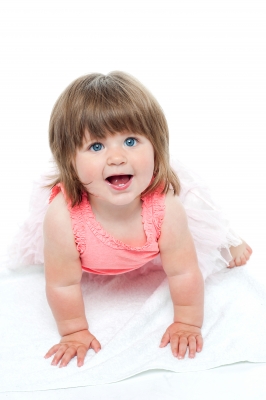
Having a baby is a life-changing experience--so it's only natural that your home will have to change as well. Bringing a tiny infant into your home can make you realize that the seemingly safe place you have been living in is actually loaded with potential hazards.
But don't panic-- baby-proofing your home doesn't have to be a fearful and nail-biting experience. With a little knowledge, shopping and careful preparation, you can turn your home into a safe and loving haven for your baby.
Get down on your baby's eye level
When you first bring your baby home, she will be unable to roam and keeping her safe is simple. However, once she starts crawling, anything on the floor is a candidate for being placed inside her mouth. The first step you should take to make your home baby-safe is to get down on the floor on your hands and knees and try to see your home from your baby's perspective. This will allow you to find things that you may not notice while you are on your feet. Look for dangerous nail heads protruding from wooden floorboards, stray wires, or small objects that can easily fit inside her mouth. Make sure any electrical outlets within reach are securely protected by outlet covers. There are a variety of outlet covers available on the market, including easy-to-use sliding covers--simply slide them to one side when you need to use the outlet, then slide it back when the outlet is not in use.
When outlets are in use, be sure to keep them blocked from your baby, so she cannot pull out the plugs and stick her tiny fingers inside the outlet.
Cover sharp edges and corners
Once your baby begins to walk, he will grab onto whatever edges are available to him to assist in his progress. Rectangular tables can have sharp edges that can be very unsafe should your baby fall and hit his head or face on the table. The best solution is to trade your rectangular tables for smoother round tables, but you can also opt to protect the corners using safety guards. These soft foam pieces apply easily to your table's rough edges and will protect your baby's delicate head from injury. They are also often removable and reusable. However, the sticky adhesive could potentially leave an unsightly residue on the surface of your table or ruin the finish.
Block stairways with gates
One of the most essential investments you will make when baby-proofing your home is a baby gate. These blockades are imperative to limit your baby's roaming to her designated safe-play areas. There are two types of gates -- hardware gates and pressure gates. Hardware gates are safer and more secure, and are installed by drilling them into the wall. While a pressure gate is safe to block a baby on level ground or at the bottom of the stairs, the gate may topple over at the top of a staircase if your baby leans her weight against it.
Lock your cabinets
As soon as your baby becomes mobile, he will get into anything and everything within his reach. You will need to purchase locks to secure your cabinet doors from your baby's prying hands. There are a variety of different locks available -- those that drill into the cabinet door, as well as locks that attach with magnets or adhesive instead. If you have handles on your cabinet doors, you can secure them even more easily with simple latch-like locks that loop through the handles.
While you may feel that locking up your cabinets is sufficient, it's still a good idea to remove any toxic chemicals and cleaning products from underneath the sink or any other lower cabinet on your baby's level. Instead, place these hazardous items in high cabinets, and stow safer items such as pots and pans in your lower cabinets.
Secure your windows
This step in baby-proofing is often overlooked. However, an open or unguarded window can pose a very dangerous threat. Make sure your baby's crib or any other furniture he can climb onto is not near any windows, and never leave any windows open while your baby is unattended. To be extra safe, purchase protective window guards that easily fit inside the frames to keep your baby from falling out of an open window. These guards have to be drilled into the frame -- if you are looking for an alternative that will cause less permanent damage, you can opt for safety netting on the window.
Blinds and shades can also be unsafe. The pull cords can pose a strangulation danger if your baby gets his head caught or tangled in the loop. You can install window cleats to keep the cord out of your baby's reach, or cut the looped cords and attach safety tassels at the ends.
Use door knob covers and locks.
Once your baby graduates to the walking phase, he may attempt to explore the world outside of your home! There are a variety of safety products available to keep your baby from opening doors, pinching his fingers, or even turning the door knob. The front door, bathroom door, basement door and any sliding doors that lead outside should all be sufficiently secured. You can also purchase helpful alarms that will alert you in the event that your baby manages to pry a door open while you are in another room.
Photo by: Stockimages (Freedigitalphotos.net)